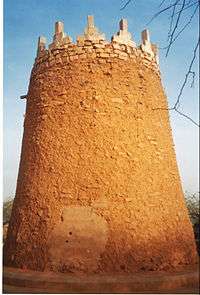Uyun AlJiwa governorate
| Uyun AlJiwa Uyun AlJiwa Governorate or Al Uyun | |||
|---|---|---|---|
| Governorate | |||
|
Sakhrat Antarah historic site | |||
| |||
 Uyun AlJiwa Location of Uyun AlJiwa | |||
| Coordinates: 26°29′55″N 43°37′56″E / 26.49861°N 43.63222°E | |||
| Country | Saudi Arabia | ||
| Region | Al-Qassim Region | ||
| Government | |||
| • المحافظ | محمد بن عبدالله الحجاج | ||
| • Governor | Mohammad bin Abdullah Al-Hajjaj | ||
| Area | |||
| • Total | 120 km2 (50 sq mi) | ||
| Population (2011) | |||
| • Total | 26,544 | ||
| • Density | 221.2/km2 (573/sq mi) | ||
| Time zone | AST (UTC+3) | ||
| Area code(s) | 06 | ||
| Website | www.OyoonJiwa.com | ||
Uyun AlJiwa (Officially: Uyun AlJiwa governorate | a.k.a. Al Uyun, Al Jiwa, and Oyounaljewa | Arabic: محافظة عيون الجواء) is a Saudi governorate that is located in northwestern Al-Qassim Region less than 30 kilometres (19 mi) northwest of Buraydah, the province capital city. The name literally translates to The Valley's Ponds, and it derives from the water ponds which used to surround the area. It is most famous for the past societies which used to live in the area and its ancient historic sites. People of Al Jiwa are distinguished from other people in Al-Qassim Region by their unique accent.
History
Many historic as well as pre-historic societies have settled in the Al Jiwa land. One example is Banu Abs who gave birth to the famous knight, adventurer, lover, and poet, Antarah Bin Shaddad. Moreover, Al Jiwa contains many Thamudic patterns (e.g. Thamudic Petroglyphs). In recent history, many of the region inhabitants' forefathers were among who are called Al Oqilat, which was a group that traveled long distances to trade, work for money, and bring back merchandise. Others were farmers and worked either in harvest or raising livestock. They were known for their loyalty, honesty, and hard work. The name of Al Jiwa has been mentioned (on record) in both Islamic and Pre-Islamic-era Arabic poetry by famous poets such as Antarah Bin Shaddad, Zuhayr bin Abi Sulma, Imru' al-Qais, Kumait Ibn Zaid, and Hassan Bin Thabit. This not only proves that Al Jiwa long-time existed, but it also proves that it held a type of status in the past.
Geography
It is important to distinguish between Al Jiwa and Uyun AlJiwa:
- Al Jiwa (without "Uyun"): translates to valley in Arabic, and it refers to the valley that contains the governorate; whereas
- Uyun AlJiwa is a name that refers to both the governorate and the main city.
Besides that, the governorate consist of 8 other towns such as Ghaf Al Jiwa (Also called Al Ghaf), Rawdh Al Jiwa (Also called Ar Rawdh), Authal, and Al Slubiya. The families living in these different towns have had-and still do share strong ties with each other.
Archaeological and historic sites

- Several old and Thamudic rock arts around Al Jiwa area. Some are vertical, some are horizontal, and two are diagonally drawn. They were found mainly in two sites:
- Al-Hanadir: Lies 15 kilometres (9.3 mi) west of the city. Drawings on two rocks were discovered there.
- Hasat Al-Nusla (also Sakhrat Antarah): A precarious boulder next to a bigger rock formation located in northern Ghaf Al Jiwa. The site sustains two historic significations:
- AlMargab: an old watchtower built with mud and adobe & located on the highest plateau in Uyun AlJiwa. Mainly, it was used to watch for approaching enemies far in distance and shout calling warnings from atop. It was recently reconstructed by Uyun AlJiwa municipality.
- The Old Souq (AlMajles): An old Saudi heritage market; the shops of which are aligned forming a circle.
- The Old Uyun (Al Uyun AlGidemah): A collection of old mud houses built with adobe, clay, and mud located in Uyun AlJiwa. Past generations of the city lived there before there were paved streets. Even though most of them were completely demolished, some of them survived the rain torrents therefor preserved as a historic site.
- The trench in northern Authal: It was dug when Banu Hilal tribe lived in the region, and the trench still exists to this day.
Agriculture
Farmers grow and harvest many kinds of vegetable and fruit, such as dates, carrots, okra, and leeks, and they also raise livestock in Al Jiwa. Some bring what they harvest and raise to sell every Monday and Friday at Souq Al Athnain and Souq Al Jumaa, which are a types of weekly flea market in the region. There are many farms spread all around the governorate. Many of them belong to the older families of Al Jiwa, and some farms are hundreds of years old. For example, AlHitan Farms are very old farms that specialized in growing and harvesting palm trees.
Major facilities
- King Fahad Grand Mosque: Built in Uyun AlJiwa on a land donated by the Finance Minister of Saudi Arabia. It includes several facilities such as Quran recitation classes, A'tikaf rooms, retail spaces, special rooms for women, and sports and recreational clubs.
- Uyun AlJiwa Hospital: Covers all the clinically essential needs for the people of the governorate. It also includes a separate building which is a renal replacement therapy clinic.
- The Social Cultural Center (Under construction)
- The Public Library: An old library building that was recently renovated by donators. It is set to include computer rooms and rooms for educational seminars and courses.
- The Main Yard (Al Hyala).
- AlKatateeb School.
References
- The information in this article is based on that in its Arabic equivalent.


